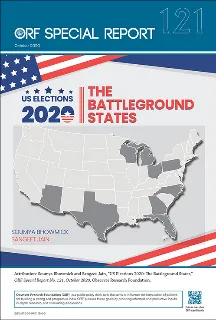The United States (US) is set to head into its 59th quadrennial Presidential Election in November. The 2020 race between Democrat Joe Biden and Republican Donald Trump was already being billed as one of the most politically fraught elections the country has seen yet, even without the help of a brewing health crisis which has upended state capacity and election processes. The incumbent, Trump, has hinted multiple times (without providing evidence) at the likelihood of fraud, indicating that he would not readily accept the results of the election. The polls will happen at a time when the country is grappling with heightened racial tensions, misinformation wars, and abounding conspiracy theories. The COVID-19 pandemic has compounded the polarisation, too, with the politicisation of health messaging around the pandemic.
This report is an exposition on the “battleground states” in the US election this year: the states that might ultimately decide the outcome of the November polls; where, by our reckoning, there are yet no clear allegiances nor evident leanings towards either party. These are Arizona, Florida, Georgia, Michigan, North Carolina, Ohio, Pennsylvania, Texas and Wisconsin—nine states with a combined 173 electoral votes between them. There are a total of 538 electoral college votes in a presidential election, of which a candidate requires 270 to win. These swing states therefore constitute a huge electoral haul, and both the Republican and Democratic parties are invested massively in campaigning in those areas.
The report aims to make two key contributions towards current analyses on the 2020 US elections. It outlines the impact of the COVID-19 pandemic on the battleground states and their economies, and captures the political dynamics and contestations around the pandemic in the states. It also provides a glimpse into the electoral history and electorate profile of each of the states, and offers a commentary on the main issues that matter to those electorates.
We also seek to break new ground in capturing the influence of the Indian-American community as an electoral constituency in these states. After all, this population has become a formidable political force in many parts of the US, due to their growing numbers and outsized impact. They are particularly high-skilled and mostly prosperous, even as they constitute a small two percent of the US electorate.1 The community has now become a microcosm—a battleground itself as Indian-Americans, once a staunchly Democratic lot on the whole, are now believed to be swerving towards the Republican Party.
A survey by Indiaspora and the Asian American and Pacific Islander (AAPI) released in September 2020 has found that 66 percent of Indian-Americans across the US favour Democratic Party nominee Joe Biden, 28 percent are for Donald Trump, and six percent are undecided—this is a significant change from 2016 when 77 percent of the Indian-American community had voted for Democrat Hillary Clinton. Al Mason, chairperson of the Trump Victory Indian American Finance Committee, has even gone to say that his own survey findings indicate that about 50 percent of Indian Americans will vote Republican this election. Foreign policy columnist Seema Sirohi has written about a perceived “shift” among oldergeneration Indian-Americans, in response to Trump’s significant overtures towards a Modi-led India and a number of spectacular rallies with the prime minister which have caught the attention of these voters. Meanwhile, many Indian-Americans view Biden’s outreach towards the Muslim-American community and the Democrats’ opposition on Indian domestic issues such as the Citizenship Amendment Act as interference and unnecessary baiting.
Does the Indian-American community possess enough clout to enable it to play a role in the electoral fortunes of either party? This report highlights some interesting numbers. The nine battleground states are home to roughly 1.4 million Indian-American voters. In one of them, Wisconsin, the Republicans won in the 2016 election with a narrow margin of 21,000 votes; the state has 37,000 Indian-Americans. Meanwhile, in Florida, also in 2016, Indian-American voters constituted two-thirds of the margin garnered by the winner. The sheer mathematical significance of the Indian-American electorate, coupled with their apparently shifting attitudes, have caused both parties to woo the community assiduously. The Democratic Party has gone out of their way to court the community separately from the larger AAPI electorate.4
The pandemic has added considerable uncertainty to the American elections this year. The Wisconsin primaries in April served a taste of the chaos that can visit the November election, if it is not managed properly. Analysts are anticipating long queues at polling places and potentially late results, and there has been an unusual amount of litigation with at least 200 cases pending in 43 states across the country regarding changes to voting rules due to the pandemic.5 The president has not helped by casting doubt on the reliability of mail-in ballots—the safest way to vote. Could the pandemic alter voter attitudes and turnout significantly? The report finds that a number of battleground states have been hit particularly hard by the virus, ranking in the top 10 states across the country with the highest death toll as of 30 September—Texas (16,132 deaths); Florida (14,317); Pennsylvania (8,224); Michigan (7,083); and Georgia (7,021). The report also gauges the impact of the pandemic on key industries in the battleground states. At present, only 38 percent of citizens approve of Trump’s handling of the pandemic, a sharp slide from the March numbers.6 The government response to COVID-19, and the political contestation around it is poised to become a key factor defining election outcomes this year.
The 2020 US election promises to be a political spectacle unlike anything the world has seen before, with far-reaching implications for the country’s domestic politics and the outlook for Indian and world foreign policy. It is the Observer Research Foundation’s endeavour to continue to provide in-depth analyses of developments in this space as they happen. This report is a contribution towards that end.
Read the full report here.

 PDF Download
PDF Download



 PREV
PREV


